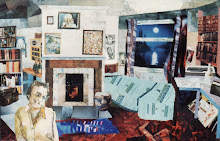A brief respite
Aimed as a lift for tiredness, not exactly “man sheds” but somewhere where you could imagine yourself away from it all – take your pick of which lodging you would like to be in! They each will be different with various implied restful activities going on. The idea originates from Yoko Ono’s show in London where she met John Lennon. There was a large presence of white half furniture, stuck to a white wall, complete incompleteness. A universe in 2D relief.
Structurally and practically speaking I would build this piece of work with a nod toward Gaudi. With added flourishes and knobbles, various bits of colour and decoration built with bits of discarded furniture and the like. In fact the whole thing would be based on found and broken bits of furniture, bits of buildings and the like. It’s a wall of relief chalet type huts (not more than a couple of feet deep), all quite serene in their own way, almost like "man sheds" (another cultural phenomena!)
Think in terms of the matchstick tree house only bigger and a lot flatter.
Would be best in a really grubby, industrialised, polluted part of town.
It being a comment about having a rest from it all, I feel that the chalets would stand out better and look more comfortable if surrounded by something that you needed to have a break from.
The roughs for this side of the project can be quite finished, because as I move along the gathering process, I will be dictated to by what is lying about or what I have been given. This board, even though 90% reconstructed, will have the ability to change, in-situ, right up to the last minute and maybe even after it has gone up and been declared open.
If I was put in the position where I had to choose one of these billboard designs, it would be this one.
- I can paint any day, anywhere but I need this kind of opportunity to explore and expose this important side of my practice. The side that is the vessel rather than the story, allowing its audience to make up their own narrative to the one home I have constructed to do just that.
Constructional notes:
I see this as a kind of “flat pack” effort.
I would build and assemble all the various parts in my studio, exactly the same size as the billboard.
I would then de-construct it; every component would be of a size that I could lift. They would be fixed onto the billboard surface with brackets.
Constructional Costs:
I do see this particular project as coming out of skips, which as an activity is a bit of an urban sub-culture in itself. I would find most of the bulky materials. Indeed I collect materials to build structures and have quite a hoard, ready to go.
Leaving:
Screws and fixings, £25,
Jigsaw £100,
Electric Screwdriver £100.
Personal Costs:
I find the costs issue quite tricky as firstly there aren’t huge fees available anyway. Secondly I’m after the billboards because I want to do them rather than get paid to do them.
If materials get covered my only basic interest is that it doesn’t cost me to carry out the project – in fact that the mechanics of production are lubricated.
Hut built at “The Edge”, Friction Arts, 2008
I was born in Shepherds Bush, London in 1951, when the area was a bit more deprived than it is now. We used to make most of our own toys. I was – of course a member of a gang and a thing we used to do a lot of was build gang huts. We used to exist from them, emerging into the light after the odd packet of fags.
We would go down to the Thames at Hammersmith and collect scrap wood that had been washed up by the tide. These huts took on many forms: underground, on stilts, multilayered, necessity is the mother of invention and we were presented with many varying challenges. These huts were a place to retreat to, a safe place, maybe it was a particularly “baby boomer” thing to do. Many of the boys I grew up with still do have their hut at the bottom of the garden where they indulge their particular passion, whether it be racing cars or racing pigeons.
The Vessel,
The thing that allows the observer to construct their own “happening”, make up personal imaginings, within a home to hold them.
Documentation
I feel that documentation is a very important part of any artists practice.
I have documentation from the past of work that has long since disappeared. It is also valuable evidence of the process involved, a history of the making of the thing. It helps to explain what it is all about, gives its reasons and can also provide glimpses of ideas and images that get rejected on the way.
It would be very important to me to document this as a project.
Potted C.V.
Born : 22-09-51, Brought up in Shepherds Bush, London.
Dip.A.D. Epsom 1974, Shows in Wales until 1980. Time in India, S.E. Asia and Turkey.
1993, moved to Birmingham, 2001 M.A. Margaret Street, since involved in various projects and shows.
I’ve painted and made things all my life, I never stop.
I have also involved myself in events and movements: musical groups, shows, projects.
I like to fit, into what everybody else is doing from time to time, concentrate on the team effort, feel comfort in the teams company, lend a hand, get stuck in.
The Balti Chariot.
From the “Green Street Show” 2007







































